Author: NorthStandard
Published: April 2024
This guide to Bills of Lading looks at the problems and practical issues common to their everyday use. It explains how to avoid disputes and challenges arising from improper usage and contains both practical guidance and theory selection that shows the legal foundations of the advice given.
The text also includes copies of relevant international conventions, an annotated copy of the BIMCO Congenbill and the latest set of recommended standard letters.
The fourth edition has been updated to reflect the useful confirmation from the courts in The Elin that deck cargo clauses can be effective to allow a carrier to contract out of liability for carriage of deck cargo.
Table of Content
Introduction
Loss Prevention and Bills of Lading
An introduction to the Fourth Edition
How to use this guide
General notes
Quick reference
How to use this section
The bill of lading -a quick guide to its role and its problems
Practical guidance
Issuing bills (paragraphs 1 -3)
Information in the bill of lading (paragraph 4)
Other matters at the time of signing (paragraphs 5 -24)
Other matters at the time of signing (paragraph 25)
Delivering the cargo (paragraph 26)
Delivery under a paper trade document (paragraphs 27 -37)
Delivery under letters of indemnity (paragraphs 38 -42)
Delivery under an electronic trade system (paragraph 43)
Change of destination during voyage (paragraphs 44 -45)
Retention of the original bill of lading (paragraph 46)
Multiple originals (paragraph 47)
Issues at time of discharge (paragraphs 48 -49)
Lost bills of lading (paragraph 50)
Photocopy or faxed bills of lading (paragraph 51)
A typical bill of lading -The Bimco Congenbill (paragraphs 52 -81)
Theory
History and context (paragraphs 82 -107)
International conventions dealing with the care of cargo (paragraphs 108 -130)
Electronic Trade Documents ACT 2023 (paragraph 131)
The shipowner?s insurance (paragraphs 132 -135)
Issuing the bill of lading (paragraphs 136 -159)
Issuance of a bill of lading when operating under charter (paragraphs 160 -184)
Duress or pressure to sign (paragraph 185)
Freight, hire, demurrage, liens, Hamburg Rules, etc. (paragraph 186)
Correcting mistakes and amending bills of lading (paragraphs 187 -192)
Switch bills of lading (paragraphs 193 -206)
What information must the bill of lading contain? (paragraphs 207 -215)
How to describe the cargo, quantity and condition (paragraphs 216 -268)
Deck cargo (paragraph 269)
What is the significance of the date of issue or the date of loading?
(paragraphs 270 -275)
Chapter Page
What is the significance of the place of issue and place of loading?
(paragraphs 276 -281)
When must the bill of lading be presented for signature? (paragraph 282)
Parcels of cargo (paragraphs 283 -285)
To whom are the bills of lading to be released? (paragraphs 286 -287)
Bill of lading carried on board in ?ship?s bag? (paragraphs 288 -289)
Other information on the bill of lading? (paragraphs 290 -295)
Sources of information for the bill of lading (paragraphs 296 -310)
Other transport documents and variations (paragraphs 311 -326)
Movement of the bill of lading under the sale contract (paragraphs 327 -339)
The voyage: deviation, delivery, loss and damage to cargo (paragraphs 340 -364)
Change of destination during voyage (paragraphs 365 -366)
Delivery of the Cargo (paragraphs 367 -393)
Other matters (paragraphs 394 -405)
Security issues (paragraphs 406 -407)
Sanctions (paragraphs 408 -412)
Electronic Bills of Lading
Background (paragraphs 413 -425)
Electronic Bills of Lading - P&I Cover (paragraphs 426 -436)
Electronic Bills of Lading - The Master?s Role (paragraphs 437 -439)
Electronic Bills of Lading - Issues that may arise (paragraphs 440 -444)
Charterparties requiring use of electronic bills of lading (paragraph 445)
Electronic signature (paragraph 446)
Electronic trade documents law reform (paragraphs 447 -454)
Legal Notes
Appendices
I Glossary of Terms
II Recommended Standard Letter of Authority to Issue Bills of Lading
III International Group of P&I Clubs Circulars
IV Standard letters of indemnity
V Hague Rules
VI Hague-Visby Rules
VII United Nations convention on the carriage of goods by sea,1978 (hamburg rules)
VIII List of countries applying the conventions
IX Carriage of Goods by Sea Act 1992
X Electronic Trade Documents Act 2023
XI International Group frequently asked questions of 21 October
2015 on paperless trading (electronic bills of lading)
Bibliography































